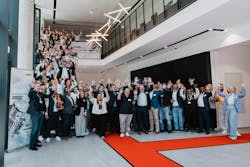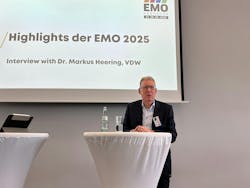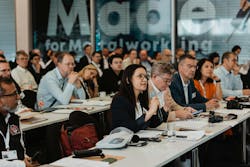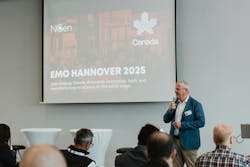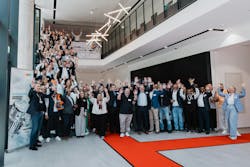Encouraging Global Industrial Dialogue at EMO Hannover 2025
In the run-up to EMO Hannover 2025, organizers of the machine tool trade fair brought together international trade journalists to drum up awareness and attendance to this year’s milestone celebration.
This year marks the 50th anniversary of the biennial event, making it the ideal platform to forge international connections between industry and production technology, as well as to explore future technologies, according to Dr. Markus Heering, executive director of the VDW (German Machine Tool Builders' Association).
“Over the last 50 years we have seen a lot of changes in metalworking industries, and EMO was always the place where innovation (first appeared),” said Heering. “This year artificial intelligence is the highlight.”
Heering raised the topics of international tariff policy, the competitive stance of German machine tool manufacturers in relation to the Asian market and the latest technological trends, all of which will be showcased at the production technology fair in Hannover from Sept. 22-26.
Building Expectations About EMO Hannover 2025
VDW, the organizer of the trade fair, invited press to attend a preview at its headquarters in Frankfurt am Main, Germany, in July. On Day 2 of the event (July 11), 80 journalists toured the ETA factory in Darmstadt, a model factory of the Technical University, where the focus was on research for climate-neutral factories.
During the main press event, 26 exhibitors made 90-sec. pitches to highlight what visitors can expect to see at EMO in September. They called attention to new product features in machines, tools, automation or quick-change systems, as well as process automation and the use of robots paired with intelligent software.
READ MORE: Hannover Messe 2025: Attend a Masterclass in Industrial Technology
In his remarks to the media, Heering talked about touring several countries, including Portugal, China, Turkey and the U.S. The EMO preview in Frankfurt is one of several events held to drive awareness about the show. One of the goals in sitting down with visiting teams from various countries, Heering said, was to ensure that the planned topics—such as automation and digital efficiency—were relevant and on target.
Predictably, some countries had unique objectives. “Of course, we have some different aspects and some different areas, and development of business cases are in some areas different,” he noted. “India is moving forward. China is a little bit different.”
Asked to elaborate on what his takeaways were from an economic and national perspective given the current state of “uncertainty,” Heering expanded on his response: “First of all, I have been asked everywhere, ‘What is my opinion about the United States and their policy?’ So, the geopolitical situation is everywhere relevant and present. We see there’s a positive development in India, also in China—positive figures, even if it's not our big ones.
“I have been mostly asked about the situation in Germany, because also within Europe, Germany is a special task. And, for me, the issue is uncertainty. What we see in the global market, especially in Germany and in Europe, is that we have multiple [market forces], not just one reason... COVID is over, there will be a recovery. We had a financial crisis before, but there will be a recovery.
“Now we have a geopolitical situation. We have wars in the Middle East, in Europe, Russia and Ukraine. We have a geopolitical issue with the situation and the competition between China and United States. We have the terrorist discussions. We have a lot of nationalism and populism coming back and trying to cross markets—‘my country first.’”
Heering further emphasized that the sector is currently facing a range of challenges, including demographic trends and concerns over rising energy costs. A recovery would take time, he acknowledged, but predicted a slow recovery is in the offing.
“I’m convinced that we see that recovery starts now, step by step, very slowly,” Heering said. “I’m looking at the incoming orders in the last month, with the slight recovery in some markets probably creepier and better. But it will be on the way back, and I believe therefore EMO is at the right time and it could offer orientation.”
Uncertainty Affects Trade Show Attendance
Heering said that visitor figures for attendance in the first half of the year indicated an interest in attending the fair. He pointed out the importance of attending events during uncertain times, particularly when disruptive technologies such as artificial intelligence are emerging. Events like EMO can provide both inspiration and clarity when companies are asking what the future impact means for their business, he said.
A Focus on the Megatrends: Automation (and AI), Digitalization and Sustainability
Skills shortages (“demographic issues”) continue to be a pain point in Europe, as it is in North America. The issue, said Heering, is that people no longer want to work on the shop floor. The next generation is more apt to look for work on computers or “would like to be an influencer,” he said.
Automation can help stem labor shortage as well as provide efficiency in the use of energy, resources and materials, he argued. Closely related to automation, digitalization has evolved to where small and medium-sized enterprises see the business case for digitalization and the need for both vertical and horizontal connectivity.
Heering said that both automation and digitalization have an influence on sustainability. “We know that resources, from raw materials to carbon-based fuels, are not endlessly available, so we have to take care of how we use them,” said Heering. “Sustainability is driven by regulations around the world.” He added that targets are also driven by partners in Asia, who query about the carbon footprint of technology and the use of energy.
EMO’s Role in Industrial Production as it Relates to Latin America and Canada
EMO has had a longstanding history of developing an exchange between Europe and the international community. And, asked specifically to comment on the Americas, Heering said that the United States plays a crucial role in manufacturing supply chains in countries such as Mexico and Canada and under current geopolitical realities are closer to the challenges faced with the United States.
However, based on Heering’s experience visiting Latin American production facilities, considerable investment is driven by technological developments and research with many European and German production plants established there.
READ MORE: Hannover Messe 2025: Attend a Masterclass in Industrial Technology
A key trend among manufacturers in the region, he said, is the growing demand for fully automated, high-end machinery capable of 24/7 operation, which offers cost advantages, especially in labor-intensive markets. He acknowledged that while large-scale automation attracts increasing orders, smaller and medium-sized enterprises still face challenges remaining competitive due to cost-per-part pressures.
Canada is EMO’s first alliance partner and will use the international stage to forge new relationships and expand existing trade partnerships, according to Jayson Myers, CEO of Next Generation Manufacturing Canada (NGen), an industry-led, not-for-profit organization leading Canada’s Global Innovation Cluster for Advanced Manufacturing.
“We do have an unruly neighbor to the south, but I think that is probably providing Canadian companies with not only a lot of enthusiasm about finding new customers, finding new suppliers, finding new innovation partners, but also about transforming their businesses,” Myers told journalists during the preview.
“One surefire way of overcoming any problem around tariffs is to become super-efficient,” said Myers and explained that this drives productivity and positions manufacturers as stronger partners. He emphasized the reach of NGen’s network, which represents about 11,000 members, including manufacturers, technology providers, universities and research institutions from across Canada, and the organization’s ability to initiate cooperation projects. The demand for investment in business models that are driven by emergent technology is served by harnessing this network, Myers explained.
“Machine learning is an AI technology, but it also assumes that there’s a machine involved, there are sensors and data collection, and assumes that there’s connectivity that brings all of this together,” said Myers.
READ MORE: Highlights from TIMTOS 2025: Adapting to Changing Market Demands with AI
Discussions about AI without considering the supporting technologies are only part of the picture. Myers compared it to needing a car to travel but being handed only a pair of tires and expected to build the rest of the vehicle yourself. “That doesn't work,” he said.
Instead, the actual value is in integrating technology to solve real industrial problems. “That’s what we do at NGen,” said Myers. “We’ve invested about two $15 million in projects that have completed today, and the return on that investment so far, over three years, is 42 times that investment in terms of sales and IP licensing.”
Internationalization of the EMO Trade Fair
EMO positions the trade fair as the “most important platform for dialogue between all international players in the industry.” Heering characterized this global orientation as a unique marker for the show. “You have other shows that may be bigger in space, but they are focused on the domestic, national markets,” he said.
The call for a global presence harks back to the VDW’s beginnings, when the show was renamed as the “Exposition Mondiale de la Machine-Outil” (the World Exhibition for Machine Tools, or EMO).”
EMO runs every two years (in a cycle of Hannover, Hannover, Milan) and brings together the world’s machine tool industry.
The press briefing was attended by around 150 participants from 24 countries, including China, India, the U.S., Canada, South Africa, Mexico and Brazil, as well as neighboring European countries.
About the Author

Rehana Begg
Editor-in-Chief, Machine Design
As Machine Design’s content lead, Rehana Begg is tasked with elevating the voice of the design and multi-disciplinary engineer in the face of digital transformation and engineering innovation. Begg has more than 24 years of editorial experience and has spent the past decade in the trenches of industrial manufacturing, focusing on new technologies, manufacturing innovation and business. Her B2B career has taken her from corporate boardrooms to plant floors and underground mining stopes, covering everything from automation & IIoT, robotics, mechanical design and additive manufacturing to plant operations, maintenance, reliability and continuous improvement. Begg holds an MBA, a Master of Journalism degree, and a BA (Hons.) in Political Science. She is committed to lifelong learning and feeds her passion for innovation in publishing, transparent science and clear communication by attending relevant conferences and seminars/workshops.
Follow Rehana Begg via the following social media handles:
X: @rehanabegg
LinkedIn: @rehanabegg and @MachineDesign
